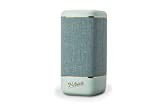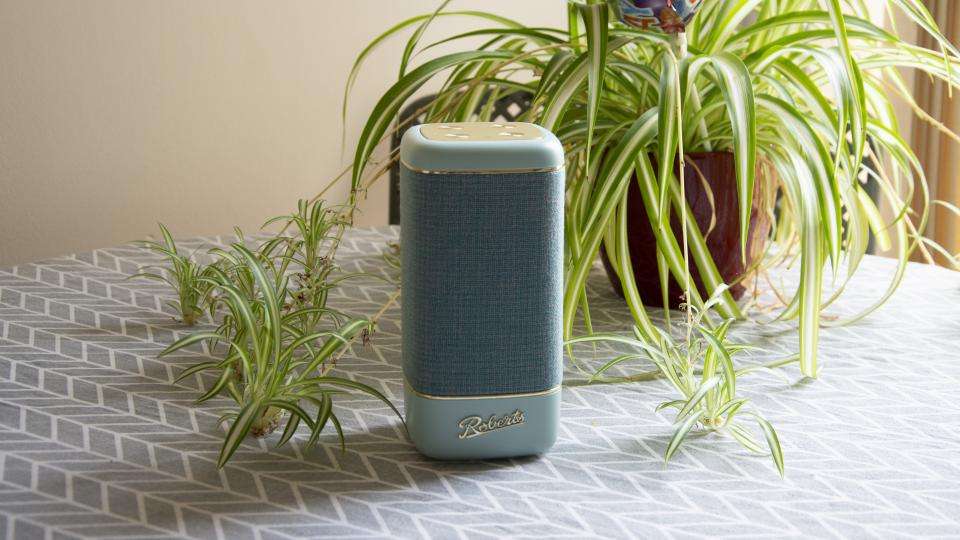Roberts Beacon 330 review: A beautiful yet limited Bluetooth speaker
British manufacturer Roberts has a reputation for creating audio products brimming with personality and its first Bluetooth speakers, the Beacon 320 and 330, are true to form. The Beacon 330 will brighten up any room it’s housed in and, stylistically at least, is a cut above the multitude of mundane Bluetooth speakers on the market.
However, when you strip back that beautiful facade, you’ll find a speaker that, though capable, lacks the muscle and versatility of similarly priced rivals.


Roberts Beacon 330 review: What do you get for the money?
The Beacon 330 will set you back £200 and comes with a mains adapter for charging the speaker. The 710g, 98 x 98 x 194mm speaker (WDH) takes around three hours to charge from empty and delivers up to 15 hours of audio playback per charge.
It has five EQ presets built-in and can be paired with multiple devices via Bluetooth, plus there’s the option to pair two Beacon 330s in stereo mode. A USB-A port on the rear of the speaker allows you to charge your various gadgets, alongside which you’ll find an AUX-in port for hooking up non-Bluetooth devices.
READ NEXT: The best Bluetooth speakers
If you’re willing to sacrifice most of those features to save yourself a bit of money, you can pick up the Beacon 320 for £150. It sports the same gorgeous looks but cuts the USB port, EQ modes, stereo pairing and can only connect to one device at a time. Battery life also takes a hit, with the 320 offering just 12 hours of audio playback.

Roberts Beacon 330 review: What does it do well?
Let’s get the most obvious observation out of the way first: the Roberts Beacon 330 is a stunning Bluetooth speaker. Gold accents border the Yorkshire-milled cloth covering the speaker’s internal components, while the cursive Roberts logo is positioned proudly on the front of the speaker’s base. Aluminium-blasted controls on the top of the device add another touch of class to a speaker oozing quality.
The Beacon 330 may be a shining example of the vintage aesthetic that Roberts is famous for but the various colours available also give a nod to modern interior design. I was sent the Duck Egg version but there are also Carbon Black, Berry Red and Pastel Cream colour schemes to choose from, though the latter two are currently only available directly from Roberts .They all look great, though the 330 range currently features one less option than the 320 series, which includes Sunburst Yellow, Charcoal Grey, Midnight Blue, Teal Blue and Dusky Pink.
Despite providing no practical benefit, I want to commend the thought that’s gone into the Beacon 330’s packaging. It was created with sustainability in mind - there’s no plastic whatsoever - and a removable cardboard panel hiding everything but the speaker’s Roberts logo adds a bit of theatre to its unboxing.
The speaker’s controls are pleasingly simple. The four-button arrangement is easy to navigate, with power, Bluetooth and volume up and volume down buttons nicely spaced out in each corner of the control panel. While paired to multiple devices, you can hit the Bluetooth button to cycle between them, which is a welcome inclusion. There’s also a nice click to the depressible buttons, though I did find the volume up button got stuck occasionally.
Five EQ options - Normal, Classic, Bass Boost, Outdoors and Speech - can be cycled through by short-pressing the power button then either the volume up or down button. When you hit the power button, a small LED reveals which mode you’re currently using via a set of distinct flashing patterns.
A single flash means you’re in Classic mode, two quick flashes are for Bass Boost mode, four represent Outdoors mode, while constant flashing illustrates you’re in Speech mode. When in Normal mode the LED will remain solid, though whichever mode you’re in, the light switches off after a few seconds of inactivity. It takes a little while to memorise the various patterns but once you’ve done so, the LED proves a pleasantly unobtrusive way of reflecting your EQ settings.
In addition to its striking looks, simple layout and variety of EQ modes, the Beacon 330 has a couple of other praiseworthy traits up its sleeve. The USB-A port located on the back of the speaker can be used to top up devices such as smartphones and headphones, while the speaker automatically powers down after 15 minutes of inactivity to save battery.
Roberts Beacon 330 review: How does it sound?
If I had to use one word to sum up audio quality, it would be restrained. The Beacon 330 doesn’t go particularly loud but is at least distortion-free at higher volumes. It’s capable of filling small rooms though there’s not the raw power needed to fill larger spaces with truly immersive sound.
Audio is delivered via a 45mm custom-made driver working in combination with two passive radiators. The radiators are different sizes, with one located on the front of the speaker and the other on the back. It’s a setup I’ve not seen used before but one that works successfully to ensure audio remains consistent wherever the Beacon is positioned.
READ NEXT: The best smart speakers
Mids and treble are articulated crisply but bass is not as impressive, even with the Bass Boost EQ engaged. It lacks impact but it is rich enough to get by. Given the Beacon 330 isn’t designed to be a party speaker, the lightweight low-end is understandable.
The other EQ modes fare better. Normal mode is well balanced across the frequency spectrum, while Classic mode - my favourite casual listening mode - sounds brighter and really highlights the Beacon 330’s ability to deliver impressive vocals and mid-range frequencies.
Outdoors mode will be the go-to for those that like their music loud: when engaged you’ll gain overall volume but at the cost of a loss in low-frequency response. Personally I found it wasn’t worth the trade-off, but my outdoors use was limited due to the weather (the Beacon 330 lacks an IP rating for water resistance so shouldn’t be used when it’s raining). Speech mode goes a step further, pushing high frequencies to the fore. It’s ideal for podcasts but you’re unlikely to use it for much else.
Roberts clearly isn’t targeting the house-party crowd with the Beacon 330, instead seeking to please the discerning listener that likely makes up the majority of its consumer base. Even after taking this into account, I still feel the 330 would benefit from a bit of extra oomph across its EQ profiles.
Those seeking a stereo experience can pick up the Beacon 330 bundle , which includes two speakers and costs £350 - a £50 saving on buying two 330s individually. As I was only sent one 330 I was unable to test its stereo capabilities but it seems simple enough to set up, with a pairing button located on the base of the speaker, and should add to immersion.
Roberts Beacon 330 review: What could be improved?
Restrained audio and lacklustre bass response aside, the Beacon 330 has a few other chinks in its armour. Track skipping and play/pause buttons are omitted, meaning that you’ll have to use your phone for these basic commands. Their omission keeps the control panel nice and simple though, so it’s hard to be too critical.
The same can’t be said for the Beacon’s lack of a microphone, which means you can’t use it as a speakerphone for calls. I’ve become accustomed to taking calls on my various Bluetooth speakers so the absence of that feature is one I felt keenly. No mic obviously means there’s no voice assistant support either. I’m perfectly comfortable living without smart functionality, but it won’t sit well with those who’ve become accustomed to controlling their speakers using Google Assistant, Siri or Alexa.
Battery life is also below average at just 15 hours. That’s less than any of the Bluetooth speakers in the £100 to £200 price range I’ve tested this year, which include the JBL Charge 4 , LG XBOOM Go PL7 , Marshall Emberton and B&O Beosound A1 (2nd Gen) .
Despite having an outdoors mode, the Beacon 330 is very much an indoors speaker. It offers no protection against the elements and you run the risk of dirtying its delightful cloth exterior when using it outside. Could this be improved? Certainly. Would doing so ruin the aesthetic qualities of the speaker and transform it into an entirely different product? Very likely. So, while it would be nice if the Beacon 330 was better cut out for external environments, it’s not something I dwelt on too long while gazing at it fondly on my desk.
Roberts Beacon 330 review: Should you buy it?
If you’re a fan of the Roberts brand and its flair for attractive design, you’ll likely have decided to buy the Beacon 330 as soon as you set eyes on it. And who could blame you, it’s a statement speaker that’s guaranteed to grab the attention of visitors and elicit compliments relating to how blooming gorgeous it looks. If I were rating it based on looks alone, it would undoubtedly be a five-star purchase.
But while there’s no shortage of style, the Beacon 330 doesn’t quite have the substance to match its eye-catching appearance. If you’re on the hunt for a Bluetooth speaker packed with customisation options and offering smart functionality or want a muscular audio experience, there are a number of superior alternatives out there.
Your comment